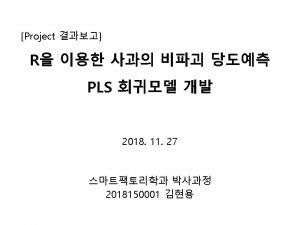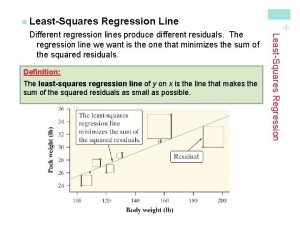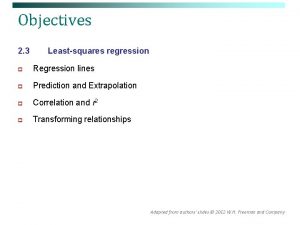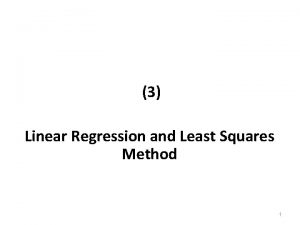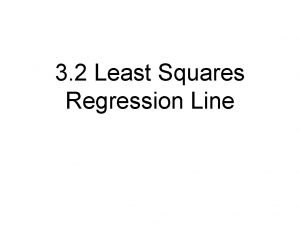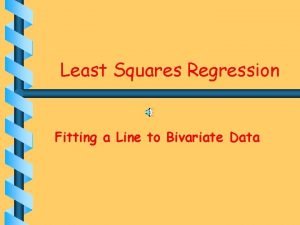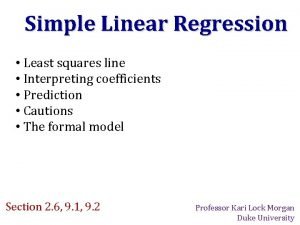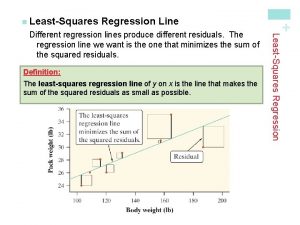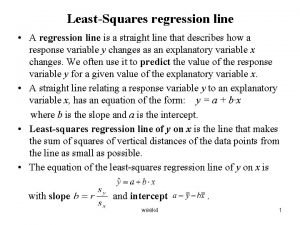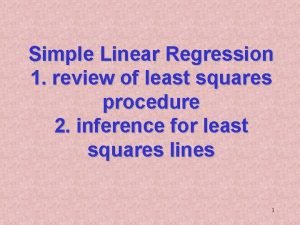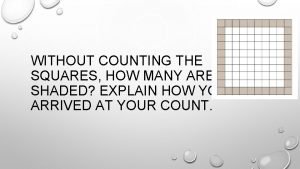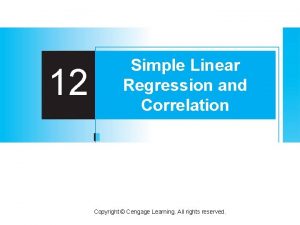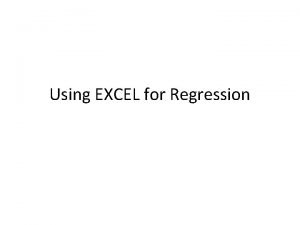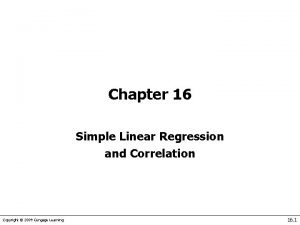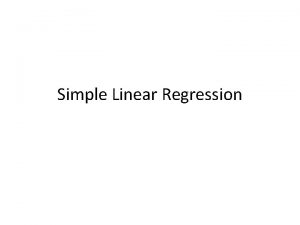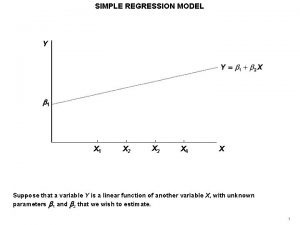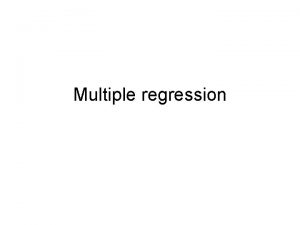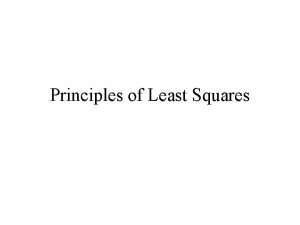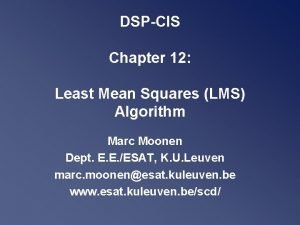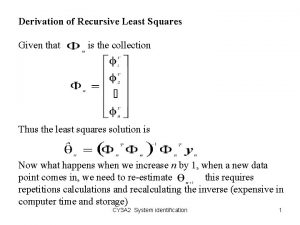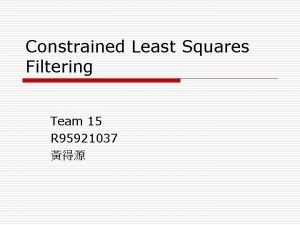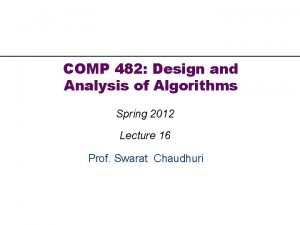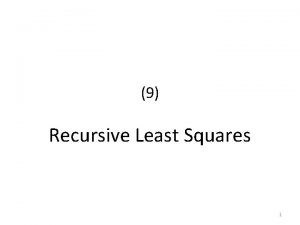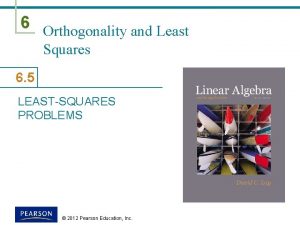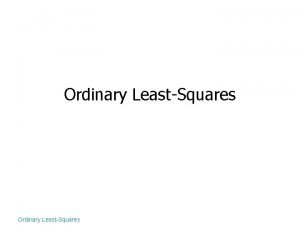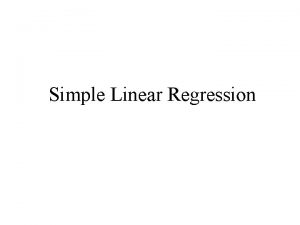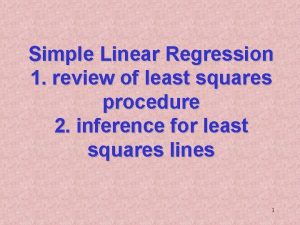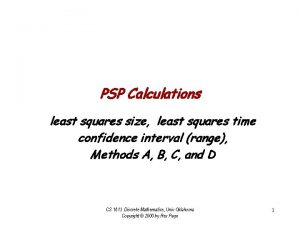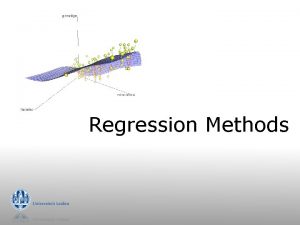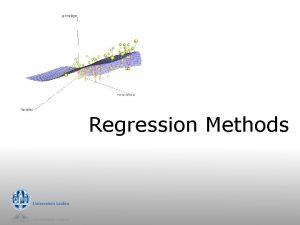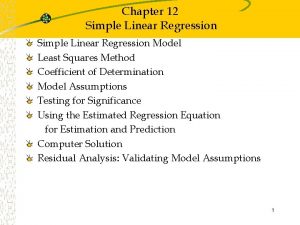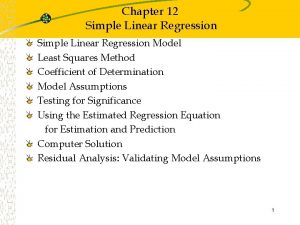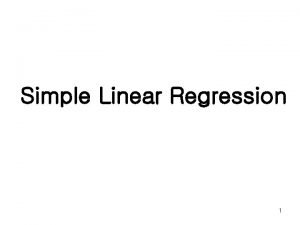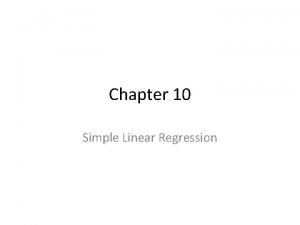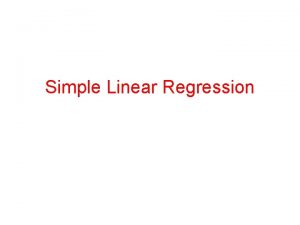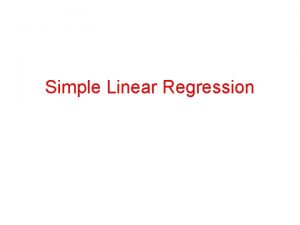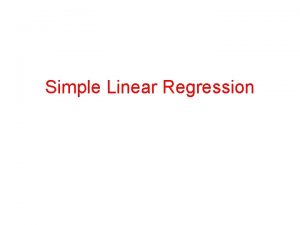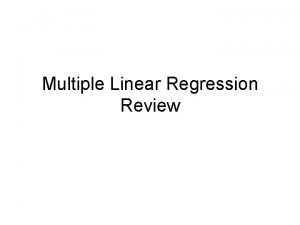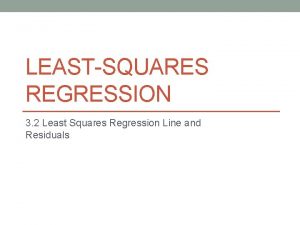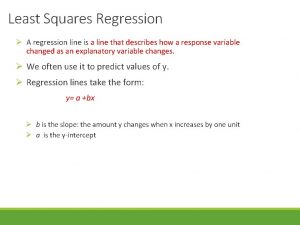Simple Linear Regression 1 review of least squares































- Slides: 31

Simple Linear Regression 1. review of least squares procedure 2. inference for least squares lines 1

Introduction • We will examine the relationship between quantitative variables x and y via a mathematical equation. • The motivation for using the technique: – Forecast the value of a dependent variable (y) from the value of independent variables (x 1, x 2, …xk. ). – Analyze the specific relationships between the independent variables and the 2 dependent variable.

The Model The model has a deterministic and a probabilistic components House Cost Most lots sell for $25, 000 t u o ab ts s o c e) e z i s hou foot. + 75(S a re 00 g a n i u 0 ld q Bui per s t = 25 s $75 se co House size 3

The Model However, house cost vary even among same size houses! Since cost behave unpredictably, House Cost Most lots sell for $25, 000 we add a random component. +e House cost = 25000 + 75(Size) House size 4

The Model • The first order linear model y = dependent variable x = independent variable y b 0 = y-intercept b 1 = slope of the line e = error variable b 0 and b 1 are unknown population parameters, therefore are estimat from the data. Rise b 1 = Rise/Run x 5

Estimating the Coefficients • The estimates are determined by – drawing a sample from the population of interest, – calculating sample statistics. – producing a straight line that cuts into the y w Question: What should b data. w w w considered a good line? w w w x 6

The Least Squares (Regression) Line A good line is one that minimizes the sum of squared differences between the points and the line. 7

The Least Squares (Regression) Line Sum of squared differences (2 - =1)2 + (4 - 2)2 (+1. 5 - 3)2 + (3. 2 - 4)2 = 6. 89 Sum of squared differences (2 -2. 5) = 2+ (4 - 2. 5)2 (+1. 5 - 2. 5)2 (3. 2 + - 2. 5)2 = 3. 99 3 2. 5 2 Let us compare two lines The second line is horizonta (2, 4) w 4 w (4, 3. 2) (1, 2)w w (3, 1. 5) 1 1 2 3 4 The smaller the sum of squared differences the better the fit of the line to the data. 8

The Estimated Coefficients To calculate the estimates of the slope and intercept of the least squares line , use the formulas: Alternate formula for the slope b 1 The regression equation that estimates the equation of the first order linear model is: 9

The Simple Linear Regression Line • Example: – A car dealer wants to find the relationship between the odometer reading and the selling price of used cars. – A random sample of 100 cars is selected, Independent. Dependent variable x variable y 10

The Simple Linear Regression Line • Solution – Solving by hand: Calculate a number of statistics where n = 100. 11

The Simple Linear Regression Line • Solution – continued – Using the computer 1. Scatterplot 2. Trend function 3. Tools > Data Analysis > Regression 12

The Simple Linear Regression Line 13

Interpreting the Linear Regression -Equation 17067 0 No data The intercept is b 0 = $17067. This is the slope of the line. For each additional mile on the odometer, the price decreases by an average of $0. 06 Do not interpret the intercept as the “Price of cars that have not been driven” 14

Error Variable: Required Conditions • The error e is a critical part of the regression model. • Four requirements involving the distribution of e must be satisfied. – The probability distribution of e is normal. – The mean of e is zero: E(e) = 0. – The standard deviation of e is se for all values of x. – The set of errors associated with different 15

The Normality of e E(y|x 3) The standard deviation remains constant, m 3 b 0 + b 1 x 3 E(y|x 2) b 0 + b 1 x 2 m 2 1) but the mean value changes with E(y|x x b 0 + b 1 x 1 m 1 From the first three assumptions we x 1 have: y is normally distributed with mean E(y) = b 0 + b 1 x, and a constant standard deviation se x 2 x 3 16

Assessing the Model • The least squares method will produces a regression line whether or not there is a linear relationship between x and y. • Consequently, it is important to assess how well the linear model fits the data. • Several methods are used to assess the model. All are based on the sum of squares for errors, SSE. 17

Sum of Squares for Errors – This is the sum of differences between the points and the regression line. – It can serve as a measure of how well the line fits the data. SSE is defined by – A shortcut formula 18

Standard Error of Estimate – The mean error is equal to zero. – If se is small the errors tend to be close to zero (close to the mean error). Then, the model fits the data well. – Therefore, we can, use se as a measure of the suitability of using a linear model. – An estimator of se is given by se 19

Standard Error of Estimate, Example • Example: – Calculate the standard error of estimate for the previous example and describe what it tells you about the model fit. • Solution It is hard to assess the model ba on se even when compared with mean value of y. 20

Testing the slope – When no linear relationship exists between two variables, the regression line should be horizontal. q q qq q q q q q q qq qq q q q qq qqq q q q q qq q q qq qq qqq q qq Linear relationship. Different inputs (x) yield different outputs (y). No linear relationship. Different inputs (x) yield the same output (y). The slope is not equal to zero The slope is equal to zero 21

Testing the Slope • We can draw inference about b 1 from b 1 by testing H 0: b 1 = 0 H 1: b 1 = 0 (or < 0, or > 0) – The test statistic is where The standard error of b 1. – If the error variable is normally distributed, 22 the statistic is Student t distribution with d. f. = n-2.

Testing the Slope, Example • Example – Test to determine whethere is enough evidence to infer that there is a linear relationship between the car auction price and the odometer reading for all three-year -old Tauruses in the previous example. Use a = 5%. 23

Testing the Slope, Example • Solving by hand – To compute “t” we need the values of b 1 and sb 1. – The rejection region is t > t. 025 or t < -t. 025 with n = n -2 = 98. Approximately, t. 025 = 1. 984 24

Testing the Slope, Example • Using the computer There is overwhelming evidence to infer that the odometer reading affects the auction selling price. 25

Coefficient of determination – To measure the strength of the linear relationship we use the coefficient of determination. Note that the coefficient of determination is r 2 26

Coefficient of determination • To understand the significance of this coefficient note: ed n i a l xp Ey Overall variability in Rem ains y b. The t r a in p , in p art, u n expl regression model d. The aine error 27

Coefficient of determination y 2 Two data points (x 1, y 1) and (x 2, y 2) of a certain sample are shown. y y 1 Variation in y = SSR + SSE x 1 x 2 Variation explained by + Unexplained variation (error) Total variation in y = the regression line 28

Coefficient of determination • R 2 measures the proportion of the variation in y that is explained by the variation in x. • R 2 takes on any value between zero and one. R 2 = 1: Perfect match between the line and the 29 data points.

Coefficient of determination, Example • Example – Find the coefficient of determination for the used car price –odometer example. what does this statistic tell you about the model? • Solution – Solving by hand; 30

Coefficient of determination – Using the computer From the regression output we have 65% of the variation in the auction selling price is explained by the variation in odometer reading. The rest (35%) remains unexplained by this model. 31
 Linear regression vs multiple regression
Linear regression vs multiple regression Linear least squares regression
Linear least squares regression Least squares regression line definition
Least squares regression line definition Least squares regression line statcrunch
Least squares regression line statcrunch Least squares regression method
Least squares regression method How to find lsrl
How to find lsrl Nonlinear regression lecture notes
Nonlinear regression lecture notes Bivariate least squares regression
Bivariate least squares regression Least squares regression
Least squares regression Www.whfreeman/tps5e
Www.whfreeman/tps5e Least squares regression line definition
Least squares regression line definition Least squares regression line minitab
Least squares regression line minitab Logistic regression vs linear regression
Logistic regression vs linear regression Logistic regression vs linear regression
Logistic regression vs linear regression Multiple regression vs linear regression
Multiple regression vs linear regression Linear regression review
Linear regression review How many squares
How many squares 4 squares = 5 9 squares =
4 squares = 5 9 squares = Copyright
Copyright Simple linear regression excel
Simple linear regression excel Useless regression chapter 16
Useless regression chapter 16 Simple linear regression
Simple linear regression Simple linear regression model
Simple linear regression model Linear regression assumptions spss
Linear regression assumptions spss Least square solution
Least square solution Lms cis
Lms cis Recursive least squares python
Recursive least squares python Explain the constrained least square filtering.
Explain the constrained least square filtering. Segmented least squares dynamic programming
Segmented least squares dynamic programming Least squares example
Least squares example Least square solution
Least square solution Least square solution
Least square solution

